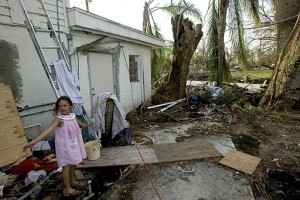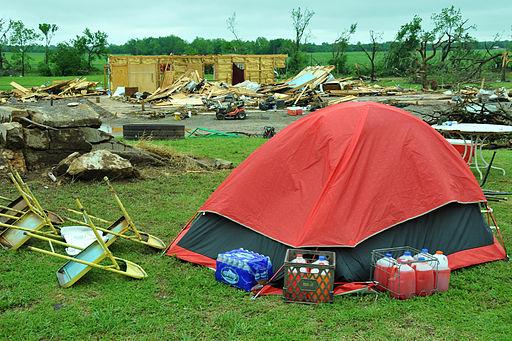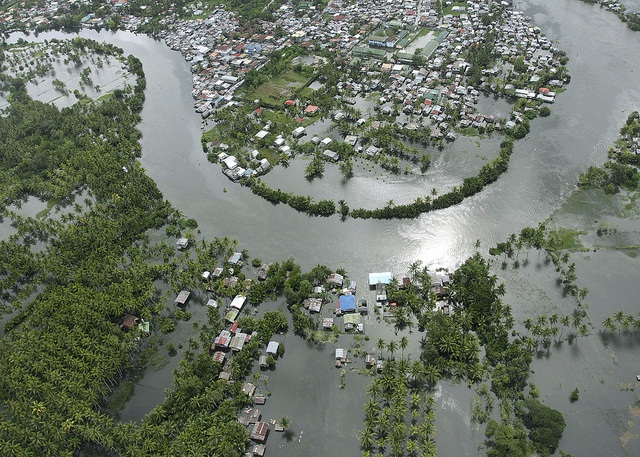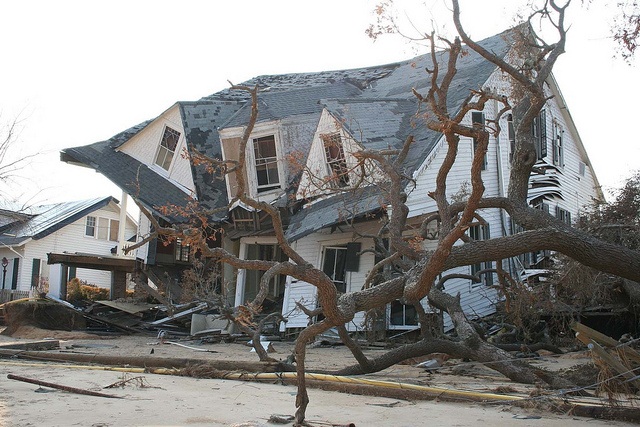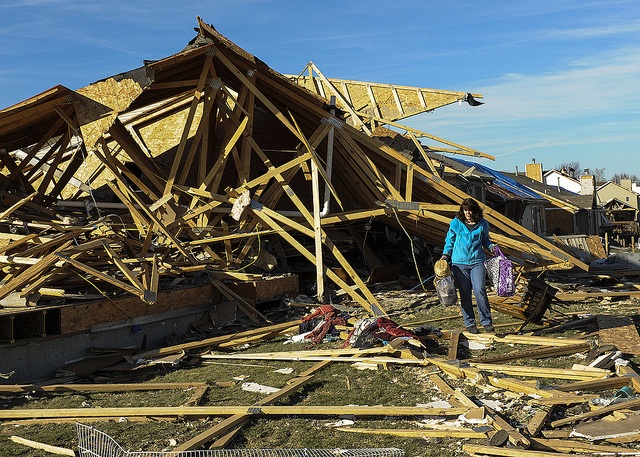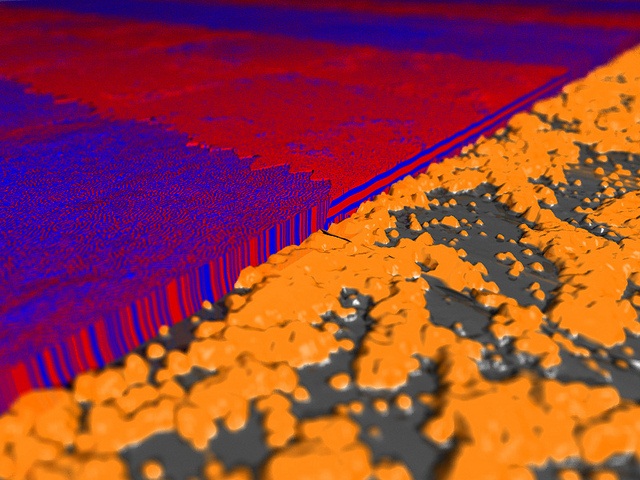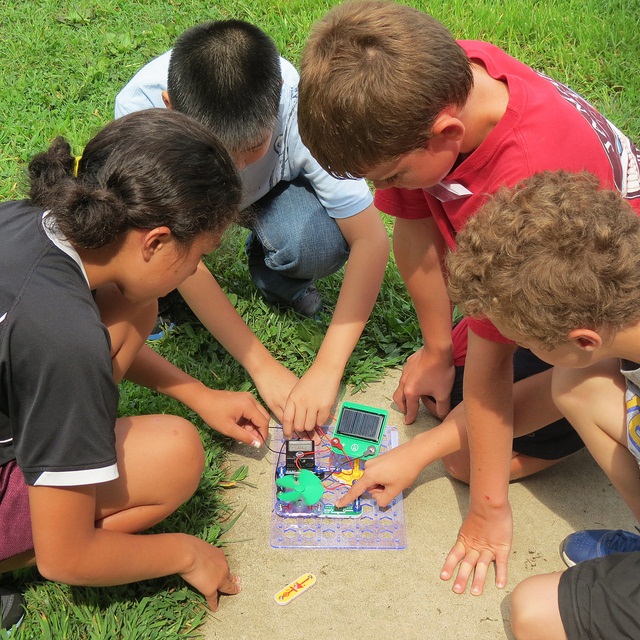Disaster-Proof Housing
Lesson courtesy of ProjectEngin CEO Ann Kaiser, an experienced engineer and educator who presented this at ASEE’s 2015 annual K-12 Engineering Workshop in Seattle.
Summary
In this activity, groups of students in middle or high school explore the housing crisis caused by natural disasters by applying appropriate technology and fluid mechanics to design sustainable shelters that can withstand flooding and high winds.
Grade level: 6 – 12 (middle school science; high school physics; engineering)
Time:
- Middle school – 4 to 6 class periods
- Physics course – 3 to 5 class periods
- Engineering course – 10 to 12 classes
Group size: 4 to 6 students
Learning Objectives
After doing this activity, students will be able to:
- Follow the engineering design process to develop solutions to address an urgent human need
- Understand the housing crisis caused by natural disasters, specifically flooding and high winds
- Apply principles of appropriate technology and fluid mechanics to design sustainable, disaster-proof housing
Skills
Engineering fields and skills: Civil, mechanical, fluids, architecture, appropriate technology, strength of materials, scaling, prototyping, design of experiment/appropriate testing.
- Problem Identification – Students research an area where hurricanes, monsoons, and typhoons often have a disastrous impact on housing. They must identify local building materials, traditional housing design, and possible storm intensity.
- Define Constraints -Key constraints are available material (set percentage must be locally sourced); technical expertise of local labor market; cost; and durability. (These should be instructor determined.)
- Determine Criteria – Students will use Criteria and Decision matrices to determine six relevant criteria and appropriate level of importance. Part of the assessment for the project will be successfully filling all criteria.
- Brainstorming/Idea Generation – Much of this will occur in researching the problem and determining criteria. Students should be encouraged to focus on the dignity and cultural appropriate of living space when making design decisions.
- Project Planning – In an engineering course, this project is suitable for developing a Gantt chart or timeline. Depending on the course, engineering or science, roughly 45 percent of the time should be spent on model construction, 30 percent on planning, and 25 percent on testing and presentation of results.
- Testing – Students are responsible for developing appropriate tests (design of experiment) and obtaining the instructor’s approval for the testing plan. All structures must be tested for an appropriately scaled level of loading, water and wind resistance, and buoyancy.
Science & Math skills and topics: Forces, buoyancy, Archimedes Principle, Bernoulli’s Principle (hydro and aero), scaling, area to volume ratios, thermal conductivity, static versus dynamic loading.
Values: Cultural empathy, empowerment, need for shelter and control, meaning of “home.”
Standards
Next Generation Science Standards
- HS-ETS 1-1 Analyze a major global challenge to specify qualitative and quantitative criteria and constraints for solutions that account for societal needs and wants.
- HS-ETS 1-2 Design a solution to a complex real-world problem by breaking it down into smaller, more manageable problems that can be solved through engineering.
- HS ETS 1-3 Evaluate a solution to a complex real-world problem based on prioritized criteria and trade-offs that account for a range of constraints, including cost, safety, reliability, and aesthetics as well as possible social, cultural, and environmental impacts.
ITEEA Standards for Technological Literacy
- Standards 1,4,6,9,11,13,20
Common Core Standards
Science and Technical Literacy
- RST.11-12.7 Integrate and evaluate multiple sources of information presented in diverse formats and media (e.g., quantitative data, video, multimedia) in order to address a question or solve a problem.
- RST.11-12.8 Evaluate the hypotheses, data, analysis, and conclusions in a science or technical text, verifying the data when possible and corroborating or challenging conclusions with other sources of information.
- RST.11-12.9 Synthesize information from a range of sources (e.g., texts, experiments, simulations) into a coherent understanding of a process, phenomenon, or concept, resolving conflicting information when possible.
- Speaking and Listening/presentation of knowledge SL.11-12.4 Present information, findings, and supporting evidence, conveying a clear and distinct perspective, such that listeners can follow the line of reasoning, alternative or opposing perspectives are addressed, and the organization, development, substance, and style are appropriate to purpose, audience, and a range of formal and informal tasks.
Engineering Connection
Natural disasters affect millions of people all over the world each year. In 2012, for example, extreme weather drove 32 million people from their homes. The biggest causes are floods and windstorms, accounting for 92.1 percent of homelessness, according to the World Bank, with earthquakes displacing just 4.4 percent.
Nearly all of those made homeless (97.7 percent) are from developing countries. People who live in the poorest countries are 10 to 1,000 times more likely to die in a natural disaster than people from countries in the top 20 percent. In other words a flood in the United States is not the same as a flood in rural India. Developing countries often fall into the “recovery trap.” They spend so much of their resources rebuilding after the last disaster that they are not ready for the next one. But city dwellers also are vulnerable: The number could be affected just by earthquakes and cyclones is expected to hit 1.5 billion by 2050.
That’s where engineers come in. They design emergency shelters such as tents with cement-like sturdiness, figure out how to rescue survivors and transport supplies, and rebuild destroyed homes and infrastructure.
Materials
Note: Some materials will be student determined. Building materials should be chosen to model real-world materials, and a list of materials needed for the scale model should be completed in all groups. In an engineering class, to highlight appropriate technology values, students should develop a real bill of materials for the actual structure.
For all groups:
- Foam core (1 sheet per group)
- Aluminum foil
- Saran wrap
- Balsa wood
- Craft sticks
- Dowels
- Pipe cleaners
- Straws
- Craft foam sheets
- PVC pipe (optional)
In addition, scissors, tape, glue, Exacto knives, tacks, wire, and string should be available to students.
Procedure/Pacing
Note: This lesson can be adjusted for student grade level with the level of inclusion of fluid dynamics and extent of determining real world feasibility.
1. Introduce the level and impact of climate disasters worldwide. Project focus is on flood- and wind-proof housing. Statistics from the World Bank, United Nations agencies and the International Red Cross are continually updated and can make a significant impact. Case study briefs can also be assigned as reading. (See Resources, below).
2. Before or after step 1, have student groups do a Quick Build with simple materials. Quick Build goals can be a house that floats, withstands a heavy load, torrential downpours, or wind.
3. Once the range of the problem is made clear, use videos from the list in Resources to showcase solutions. TED Talks are particularly appealing to high school students.
4. Allow students time to research an area of world/natural disaster that they would like to design for. Students should identify relevant constraints and criteria. A Design Brief form is helpful at this point. Cost for actual structures ($100-$2,000), percentage of local material and labor, lifespan (2-5 years minimum), and number of inhabitants can be instructor provided constraints. Criteria should be developed by students and should form part of the assessment for the project.
5. Students need to understand static issues of buoyancy and dynamic issues of both air and water flow. More emphasis can be put on this in physics classes and actual calculations can be included as part of the project requirements. In an introductory physics class, quantitative emphasis can be placed on buoyancy calculations and the use of Bernoulli’s Principle can remain qualitative.
– Introduce Archimedes Principle and relevance of volume and weight in design. Concepts of dead load and live load. Test quick build prototype to see how much a small piece of foil can hold when surface area to volume is maximized.
– Introduce Bernoulli’s Principle in terms of wind creating high velocity region of low pressure. Simple experiments with a piece of paper can convince students that the walls and roof can blow outward due to lateral wind flow.
– In regions where erosion may of concern, high flow rates are an issue, and students will also need to consider the Principle of Continuity.
6. Forces and issues of loading in tension and compression should also be discussed. The impact of wind blowing perpendicular to the surface and weight of water are significant issues that need to be considered when testing. Comparisons of different types of building materials can be made.
7. It is important that students focus on the use of local materials and technology. What works in the United States may not be a sustainable or culturally acceptable design somewhere else. Values such as empathy, cultural awareness, basic human dignity and a sense of home are critical for a successful project. Students in an Engineering class can be asked to fully research available local materials and complete a “Bill of Materials.”A cost limit between $1,000 and $2,000 is recommended.
8. Scale models need to be tested to meet appropriately scaled criteria. The idea of design of experiment (DOE) to verify claims is a significant one in new technologies. A simple form for recording testing rationale and data should be created indicating testing parameters, results, and observations. It is suggested that one test be a scale model load test, specified by the instructor, and that two additional tests be developed to test for compliance with criteria and constraints. This can include buoyancy, wind resistance, and flood resistance, along with students generated concerns such as portability, quick assembly, etc. These two additional tests should be student generated and instructor approved.
9. If time permits, opportunities to modify are very valuable in terms of the engineering design process. All modifications should be isolated (done one at a time) as much as feasible and a rationale for the modification should be required.
10. If time and resources permit, encourage students to present their results in a video recording of the design/build/test process and wrap up the presentation with a “sales pitch” selling their structure to local authorities or international development groups. Other formats for final reporting can be used if time is limited (i.e. PowerPoint, report, full design brief). It is strongly suggested that groups keep all forms and notes in an Engineering Notebook (binder) on order to have thorough documentation of the process they followed. The Engineering Notebook should be part of the grade.
Assessment
Deliverables:
- Process documentation – Engineering Notebook (Engineering class) or key forms (Science class). Samples of forms are contained in this file.
- Product documentation – The actual scale model, before and after testing.
Overall – Group report, presentation, or video
Details:
- Suggested individual/group 25%/75%
- Checklist for all forms indicating level of effort and completeness
- Success in meeting constraints and criteria
- Periodic in class observations and discussions with group
- Clear calculations where required
- Successful testing protocol and results
- Presentation of completed project
Sample assessment scoring breakdown:
- Completed/Comprehensive Engineering Notebook 20 points
- Group Focus/Effort in Construction 10 points
- Successful Building
- — Meets Criteria/Constraints 10 points
- — Passes Tests 10 points
- Communication of Process and Results 25 points
- Individual Contribution 25 points
Housing and Building Resources
- Architecture for Humanity
- Open Architecture Network
- Appropriate Infrastructure Development Group
- Can the Global Housing Problem be Solved? (Groundwork.org)
- Global Housing Foundation
- World Health Organization’s Health Impact Assessment
Development issues – information and statistics
- United Nations Development Program
- Better Life Index, Organization for Economic Cooperation and Development
- World Bank
International Committee of the Red Cross - Annual Disaster Statistical Review 2013: Numbers and Trends
Solutions
- Proposal for Domed Houses Made of Inflated Concrete (Wired, 7/14)
- Low- and High-tech Solutions to Natural Disasters (TechCrunch 4/9/15)
- Government Buildings: Disaster Recovery (Sprung High Performance Fabric Building Solutions)
- Can a House Be Typhoon-proof and Earthquake-proof at the Same Time? (NextCity.org)
- Disaster Resistant Replacement Houses
- Humanitarian House International
- Designing and Developing Sustainable Housing for Refugee and Disaster Communities (IEEE-Global Humanitarian Technology Conference paper, Oct. 2014; PDF)
Agencies, nonprofits, NGOs
- Build Change. Great nonprofit with appropriate technology focus/lots of resources and info on website
- Red Cross World Disasters Report 2014
- World Bank Housing Resources (PDF monograph, circa 2000)
- Handbook for Reconstruction
- Habitat for Humanity Cities
- Kellogg Institute at Notre Dame’s Engineering Outreach program
Videos/TED talks
- Diebedo Francis Kere: How to Build with Clay and Community
- Dan Phillips: Creative Houses from Reclaimed Stuff
- Cameron Sinclair on Open Source Architecture
- Ernesto Sriolli: Want to Help Someone? Shut Up and Listen!
- Young U.S. designer Michael McDaniel: Cheap Effective Shelter for Disaster Relief
- Peter Haas: Haiti’s Disaster of Engineering
- Sigeru Ban: Emergency Shelters Made from Paper (inspiring)
- Dome Home: Disaster and Third World Housing Solution (YouTube 2:00)
- Video BBC science environment
- Nat Geo 2014 Top 10 Natural Disasters of All Time (approx. 1.5 hours)
- Video from Notre Dame Engineering to Empower about Haiti in 2012
Design Briefs/Case Studies
- Technical Brief on Bangladesh
- 10 Shelter Case Studies from the Red Cross. Good info for design briefs
- South Pacific Islands. UN-sponsored report, good background for design brief on region.
- 1990 Earthquake Resistant Housing in Peru
- Tonga – Building Back After Cyclone
- Global Facility for Disaster Reduction and Recovery
- Climate Risk in Sri Lanka
World Bank Case Studies – good background information, overall focus is financial structures and managing response:
- Mozambique – case study about recurrent floods
- Laos – Typhoon Ketsana
- Philippines – Typhoon Haiyan (Yolanda)
- Senegal – Urban Flooding
- Yemen – Tropical Storm 2008
Engineering Schools: Humanitarian-focused K-12 Outreach and Academic Programs (compiled eGFI Teachers)
- National Academy of Engineering’s Grand Challenges Scholars Program
- Purdue University EPICS program (Engineering Projects in Community Service is offered in high schools and universities nationwide)
- Engineers Without Borders (Campus chapters nationwide)
- Engineering for Change (list of humanitarian engineering programs at universities and online)
- Humanitarian Engineering Center, Ohio State University
Filed under: Class Activities, Grades 6-8, Grades 6-8, Grades 9-12, Grades 9-12, K-12 Outreach Programs, Lesson Plans | Comments Off on Disaster-Proof Housing









